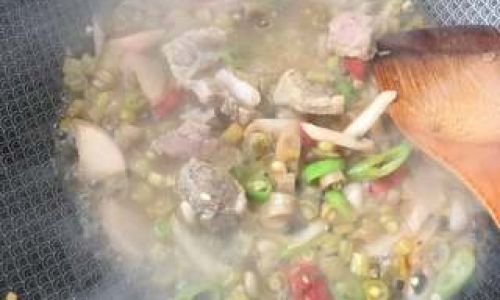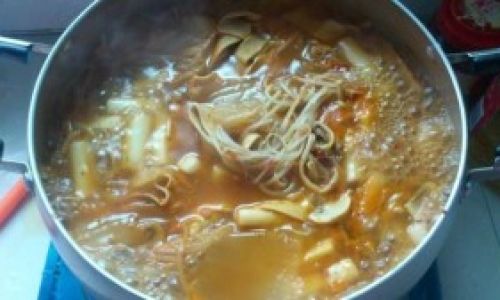Introduction
Kimchi beef seafood soup, a delightful fusion of Korean flavors combined with the richness of beef and the freshness of seafood, is a dish that promises to tantalize your taste buds. This hearty soup combines the tangy, slightly spicy taste of kimchi with tender beef and an assortment of seafood, creating a meal that is both comforting and exhilarating. Whether you’re a seasoned chef or a home cook eager to try something new, making kimchi beef seafood soup can be a rewarding culinary adventure. In this guide, we’ll walk you through every step of the process, ensuring you create a dish that is as visually appealing as it is delicious.
Ingredients
Before diving into the cooking process, let’s gather all the necessary ingredients. For the kimchi beef seafood soup, you’ll need:
- Kimchi: 2 cups, preferably homemade or high-quality store-bought. Kimchi adds a tangy, slightly fermented flavor to the soup.
- Beef: 1 pound, thinly sliced. Flank steak or brisket work well for this dish.
- Seafood: A mix of your favorite seafood such as shrimp (1/2 pound, peeled and deveined), squid (1/2 pound, cleaned and sliced into rings), clams (1 dozen, scrubbed), and mussels (1 dozen, debearded and scrubbed).
- Onions: 1 large, thinly sliced.
- Garlic: 4 cloves, minced.
- Ginger: 1 tablespoon, minced.
- Green onions: 4 stalks, chopped. Reserve some for garnish.
- Sesame oil: 2 tablespoons.
- Soy sauce: 3 tablespoons.
- Gochujang (Korean red pepper paste): 2 tablespoons, adjust to taste for spice level.
- Sugar: 1 teaspoon, optional, to balance the flavors.
- Fish sauce: 2 tablespoons, for added umami.
- Chicken or vegetable broth: 6 cups.
- Tofu: 1/2 block, optional, cut into small cubes.
- Rice cakes (dduk): 1/2 cup, optional, sliced into bite-sized pieces.
- Sesame seeds: 1 tablespoon, for garnish.
- Salt and pepper: To taste.
- Vegetable oil: For cooking the beef.
Instructions

Step 1: Prepare the Ingredients
Begin by preparing all your ingredients. Slice the beef thinly against the grain to ensure it cooks evenly and tenderizes. Clean and chop the seafood, ensuring shrimp are peeled and deveined, and squid is sliced into rings. Slice the onions thinly, mince the garlic and ginger, and chop the green onions, reserving some for garnish.
Step 2: Cook the Beef
In a large pot or Dutch oven, heat a tablespoon of vegetable oil over medium-high heat. Once hot, add the sliced beef in a single layer, avoiding overcrowding. Season with salt and pepper. Cook the beef until browned on all sides, about 2-3 minutes per side. Remove the beef from the pot and set it aside. This step helps to build flavor in the pot and ensures the beef remains tender.
Step 3: Sauté the Aromatics
In the same pot, add another tablespoon of vegetable oil. Add the sliced onions, minced garlic, and minced ginger. Sauté until the onions are translucent and the aromatics are fragrant, about 3-4 minutes. This creates a flavorful base for the soup.
Step 4: Add Kimchi and Seasonings
Add the kimchi to the pot, along with its juices. Stir to combine with the aromatics. Add the gochujang, soy sauce, sugar (if using), and fish sauce. Stir well to coat the kimchi and aromatics with the seasonings. Cook for about 5 minutes, allowing the flavors to meld together.
Step 5: Add Broth and Simmer
Pour in the chicken or vegetable broth. Stir to combine all the ingredients. Bring the mixture to a boil, then reduce the heat to low and let it simmer for about 15-20 minutes. This allows the flavors to deepen and the broth to develop a rich, savory taste.
Step 6: Add Seafood and Beef
Once the broth has simmered for the required time, add the cooked beef back into the pot. Follow with the seafood – shrimp, squid, clams, and mussels. If using tofu and rice cakes, add them at this stage too. Stir gently to combine.

Increase the heat to medium-high and cook until the seafood is cooked through and the clams and mussels have opened (discard any that remain closed). This should take about 5-7 minutes. Be careful not to overcook the seafood, as it should remain tender and juicy.
Step 7: Taste and Adjust Seasoning
Taste the soup and adjust the seasoning as needed. You may want to add more soy sauce, fish sauce, or gochujang for flavor. If the soup is too tangy for your taste, you can balance it with a pinch of sugar.
Step 8: Garnish and Serve
Once the seafood is cooked and the soup is to your liking, remove the pot from heat. Garnish with chopped green onions and sesame seeds. Serve the kimchi beef seafood soup hot, with a side of rice or noodles if desired.
Serving Suggestions
Kimchi beef seafood soup is a meal in itself, but you can pair it with a few sides to enhance the dining experience:
- Rice: A steaming bowl of white or brown rice is the classic accompaniment.
- Noodles: Udon, soba, or even rice noodles can be added to the soup or served on the side.
- Banchan (Korean side dishes): Consider serving your soup with a few banchan such as pickled radishes, spinach salad, or seasoned tofu.
- Kimchi: Extra kimchi on the side never hurts, especially if you’re a fan of its tangy, spicy flavor.
Storage
Leftover kimchi beef seafood soup can be stored in an airtight container in the refrigerator for up to 3 days. Reheat gently over low heat, adding a splash of broth if needed to loosen the consistency.
Conclusion
Making kimchi beef seafood soup may seem like a complex process, but with the right ingredients and careful attention to each step, you’ll be rewarded with a dish that is bursting with flavors and textures. This soup is not only a delightful meal but also a testament to the versatility of Korean cuisine, which seamlessly blends traditional ingredients with modern twists. Whether you’re hosting a dinner party or simply treating yourself to a hearty meal, kimchi beef seafood soup is sure to impress. So, gather your ingredients, roll up your sleeves, and embark on this culinary adventure – your taste buds will thank you!






0 comments